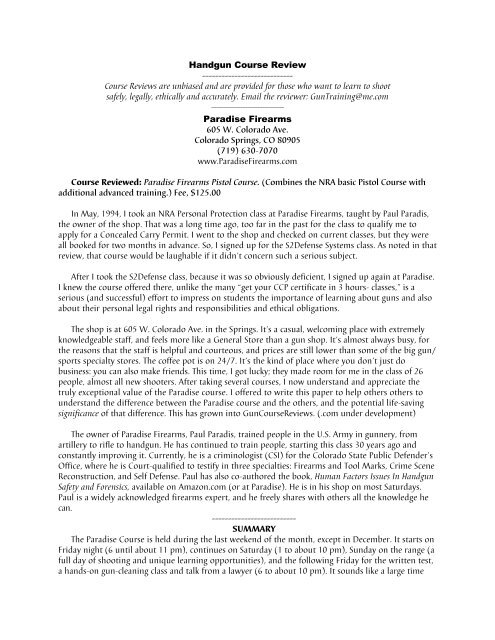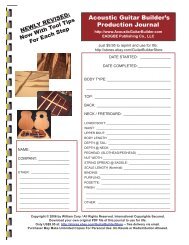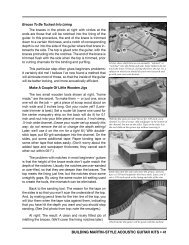Paradise Firearms Pistol Course (pdf)
Paradise Firearms Pistol Course (pdf)
Paradise Firearms Pistol Course (pdf)
You also want an ePaper? Increase the reach of your titles
YUMPU automatically turns print PDFs into web optimized ePapers that Google loves.
commitment, but if you seriously want to learn about firearms, their legal and ethical use, yourresponsibilities with them, and how to handle them safely and shoot them accurately, this is thecourse to take. In my opinion, it is severely under priced. Any other course like this, if you can find it,costs over $500; this one is $125. The 55+ volunteer instructors (including two attorneys) who providetheir time and expertise to help students learn safe gun handling and shooting, in themselves, areexperienced and exceptionally dedicated to the principle purpose of the course: Teaching about gunsand their proper use.--------------------------DETAILSFriday night (classroom)We (26 students) were issued a packet of information to keep that included a copy of NRA Guide tothe Basics of <strong>Pistol</strong> Shooting, and additional information. We spent over five hours (6:15 PM to 11:50PM) learning about safety, revolvers, and semi-Automatic handguns. We had three NRA certifiedinstructors. One lectured for an hour on safety. Two other NRA instructors taught separate sections onrevolvers, and on semi-autos, using demonstrations, multi-media presentations, oversize models, andreal guns. The instructors, all volunteers, were patient, easily heard and understood, and professional.Each of them is an expert in the area he or she teaches, as are all of the lecturers and instructors whoteach in this course.Saturday (classroom)We reconvened at 1:00 PM; they “warned us” we’d go late, with a dinner break for pizza. We eachbrought our gun if we had one, but absolutely no live ammo was/is allowed in the classroom. Thatmorning, the shop had fitted and supplied any non-gun-owning students individually with a gun theycould handle, that felt good to them, and that the shop staff felt was right for them, for their useduring this session and to shoot on Range Day (Sunday). The shop provides these guns for students’use at no extra charge; many brands and calibers of revolvers and semi-autos are available.Saturday’s teaching started out with another NRA Instructor doing 2.5 hours about firingfundamentals: Basic stances, grip, breathing technique, aiming, firing, and follow-through. Then wewent outside with our unloaded guns, students and a large number of instructors, to practice ourstances. We were taught three stances (isosceles, strong isosceles, and one-handed), and drilled onthem for about two hours with our real, but unloaded, guns. Then, back into the classroom after aten-minute break for instruction on various types of handgun ammo: nomenclature, parts andfunctions, how to handle and clear misfires, hang fires, misfeeds, and squibs, how to get the correctammo for the gun, real-world problems caused by wrong ammo or aggressively reloaded cartridges,and more. Since <strong>Paradise</strong> offers extensive gunsmith services, they have on hand many guns people havedestroyed by using wrong or too-powerful reloaded (non-factory) ammo; these are good examples.We all threw in $5 each for pizzas and ate all we wanted. Then, back to instruction.Following the dinner break, Michael Salkind, a local criminal defense lawyer, taught for two morehours on what we should really expect, legally, if we ever are forced to use our gun for self-defense,inside or outside our home. Salkind has worked with Paul Paradis on several shooting investigationsand court cases. He provides his legal knowledge for the class on a volunteer basis. He is not a gunowner and he does not shoot guns. But, he is a Constitutionalist and backs the 2nd Amendment Rightof gun ownership; he supports its application to individuals, not just to “standing armies” ororganized militia. During the class, many legal questions were asked and answered. There were laughs,since Salkind is a pretty funny guy, but this serious point came through: It is your right to own a gun for
self defense — but, if you can avoid a gun confrontation, do it! This session was extremely enlighteningand sobering, and probably the only time we’ll ever interact with a practicing criminal defenseattorney for such a low price!To end, Paul told us more about the range the next day. We were dismissed at 11:15 PM.Sunday (Shooting Range)We met at 8:30 AM at the shop and arranged caravans for the 30-mile trip to Cactus Flats ShootingRange (an excellent outdoor range) in Penrose. At about 10 AM, we all gathered on the rifle range.(My times are approximate since the day just flowed.) We had four lectures: One on black powderrifles and gun history, one on range safety procedures, a shotgun and revolver demonstration, and atalk on general objectives for the day. All students were issued ear and eye protection that they couldkeep. (Not just ear plugs, either, but protective mufflers.)The “Round Robin,” as they call it, got started at about 11 AM. This is an opportunity for everystudent to experience shooting a few rounds through each of the following guns: .22 single-actionpistol standing, .22 semi auto on bench, .380, 9mm, .40, .45 semi-autos, .38 double-action, .357 singleactionrevolver, and then an AK-47 or Colt AR-15 military-spec, three shotguns (.410 cal, 20 gauge and12 gauge), and black powder rifle. (Specific guns vary at times.) At each station, multiple brands ofguns in calibers above were available to shoot: we took our choice, and the instructor—one instructorstanding beside each student at all times dedicated for each shooting station—explained the specificsof that gun’s operation, gave us cartridges to load, and let us fire downrange. In the Round Robin,targets aren’t used; the point is to experience shooting various guns, and to practice on stance, grip,breathing, trigger control and other fundamentals. For students, it’s just plain fun! (Seriously, whereelse could you do this?) Needless to say, this Round Robin is not part of the standard NRA course; itisn’t offered anywhere else, in any other course that I can find.Next, we broke for lunch, our bag lunch or a great home-cooked buffet for just $5, in the airconditioned(and heated if needed) clubhouse, where nice, clean indoor restrooms are also provided.After lunch, we had an afternoon of instruction and target qualifying using our own guns. We eachshot 100 rounds, with the last 50 to test our accuracy at 10 and 25 feet. Every student in this class hashis or her own personal instructor for the full afternoon. This is exceptional, like so many otherfeatures of this course are. The first 25 rounds are used to practice correct stances, grip, breathing andtrigger control, at 10 and 25 feet, using “point shooting” and the isosceles stance. Each student’sinstructor provides constant feedback and instruction.The next 25 rounds are shot in a section called “Ball & Dummy”: Some hammer-falls are on liveammo, and some are on already-shot rounds, which don’t fire. The student pulls the trigger about 200times to fire those 25 live rounds. The purpose of the drill is to spot and correct the student’sproblems in flinching (anticipating recoil), incorrect grip, breathing, stance and trigger control, andfollow through. All of these are more easily spotted when the student is expecting the gun to fire, butit doesn’t. During the drill, the instructor has the student turn away, loads at random either a live ordummy cartridge, then has the student turn around and fire. Some go bang, others just click. It is arevealing drill and shows the student where he or she needs to improve, since the student’s flinch andother bad habits are easy to feel and see when the gun doesn’t fire and recoil.After a short break, “qualifying” begins. NRA’s basic pistol course calls for shooting, but doesn’trequire actual “qualifying,” so it isn’t clear what the real purpose of this is, but it’s a great feeling to
do it and pass it! For those who have never shot a gun, it proves the training has worked for them.When the range is declared “clear” by the RSO (Range Safety Officer), firing commences. Thestudent does his or her own loading and firing, at will, with an instructor at his or her shoulder. Thefirst stage is at a 12-foot firing line, the muzzle about ten feet from the target. The target is a 4” by 6”horizontal rectangle, simulating the center-of-mass/heart-lung area, in a black and grey drawing of atorso. Hitting in the rectangle is 5 points per shot; hitting in the surrounding grey area is 4 points pershot, and hitting in the black outer torso area is 3 points per shot. After all students have all finishedfiring 25 shots from the 12-foot firing line, all move back to the 25-foot firing line and fire 25 moreshots. The Qualifying Score is 180 points of 250 possible; every student in my class qualified. I was firinga brand new Ruger SP101 double-action .357 revolver, using .38 Special ammo. I’m not an expertmarksman, and I am not a total beginner, but more of a “beginner-intermediate” guy. I got a goodscore (246/250), probably because I simply listened to and used all of my instructor’s hints and tips,and began to overcome and remove some of the bad habits I had developed through watching toomuch of Jack Bauer on TV.(BTW: Over 7,000 students have been taught in 30 years, and <strong>Paradise</strong> has had only one injury onthe range—when a student sat on a cactus … ouch.)At about 4:30 PM, after we cleaned up the range, that was about it. We went to the clubhouse andhad a short meeting, gave the excellent (all-volunteer) instructors a big round of applause, thankedthe Cactus Flats range people for giving us the entire range for the day, and headed home. The grouphad an open dinner invitation at a restaurant in Colorado Springs.Final Friday Night (classroom)The following Friday, we met again at the shop for a final class, starting at 6:15 PM and ending at11:30 PM.We “learned by doing,” how to correctly clean our guns and the guns the shop provided, and tohave a final lecture on Avoiding Confrontation. We took and graded the 50-question multiple choiceand true/false test required to pass for the course completion certificate. Another attorney and formerSan Diego, CA, police officer, Tim Priebe, and Paul Paradis, lectured on how to avoid confrontations andbe prepared for certain situations. We received handouts and information on the Colorado CHP(Concealed Handgun Permit), info on open-carry vs. concealed carry, and how to deal with routinetraffic stops if we have a gun in the car or are carrying legally. Students who passed the written test(all of us, since we had a full week to study the NRA book) were given our certificates, and we were alldone.As a student, my endorsement might not mean much. I hope this detailed description of thecourse does help people. However, an endorsement that struck me came from Tim Priebe during thefinal Friday night. He said: “I learned more when I took this course five years ago, than I did in firearmstraining at the San Diego Police Academy.” That says a lot, in my opinion. I’ve heard similar statementssince then from police officers and from active US Army and Air Force personnel.Total instruction time for this course: about 26 hours, including 8 hours of actual shooting andinstruction on the range. This has to be the equal of any beginner/intermediate shooting courseavailable anywhere, regardless of cost. At <strong>Paradise</strong>, they obviously don’t do this for profit, but to teachsafety and basic skills.
__________________SUMMARYIf it sounds as if I am exhibiting favoritism toward this course, as compared to the other courses inthese reviews, that is all right. This course is head and shoulders above the others, does not put aprofit motive ahead of teaching, and provides students with the information they need to be safe gunowners and accurate shooters, and to know their legal rights and responsibilities. That is what a “guncourse” should do. It is what a gun course should achieve, but too many others don’t even try.Final Grade for the <strong>Paradise</strong> <strong>Firearms</strong> <strong>Pistol</strong> <strong>Course</strong>: “A” Did the class fulfill the lesson plan itpublished? Yes. Does it fulfill the real requirements of a new shooter? Yes.Ratings: (Points earned/Points possible) Total: 100 out of 110 possible[Note: Rating revised upward from sheet shown elsewhere in these reviews.]Safety, 10/10 -- instructors ALL continually stressed the 3 basic rules and general safe handlingHandgun Types, Parts & Operation, 10/10 -- excellent, detailed instruction; guns handed aroundAmmunition, 10/10 -- excellent, detailed instruction; oversize dummy “cartridges” and illustrationsClearing Jams & Firing Problems, 8/10 -- well-covered and described but not hands-on practiceSight Picture & Aiming, 9/10 -- well-covered, but did not fully address individual eyesight problemsFiring Fundamentals, 8/10 -- good, but could have taken into account individual physical problemsCleaning & Maintenance, 9/10 -- excellentLive Firing on Range, 20/20 -- excellent: Safe, detailed, extensive, over 100 shots plus “Round Robin”Classroom Setting & Instructor, 8/10 -- classroom crowded; instructors great; far above expectationsLegal Instruction, 8 -- two lawyers and Paradis gave expert, qualified advice based on experience------------------------------------Comments? Questions? Please send them to: GunTraining@me.comMy name is not included here because I am, for practical purposes, a “secret shopper.”© 2010 BeginnerHandgunTraining.com … but feel free to copy and distribute if completely intact.Please read and ask the questions (next page) of any course provider from whom you areconsidering taking a gun course.
Questions To Ask Gun <strong>Course</strong> ProvidersWhen taking a gun course—especially a beginner course—communication is essential. Many guncourses don’t provide good, accurate or adequate information, as we’ve discovered by taking several.There are those that do provide good information, but you have to ask questions to find them.------------------------------Ask These Questions1) How much time is spent in the classroom? Does it include gun safety, gun operation for bothrevolvers and semi-autos, ammunition basics, stances, grip, sight picture, breathing, trigger control, andfollow-through? How about clearing jams? Does it include actual cleaning of the guns?2) How about legal instruction? Does it include information either in person, in writing, or onvideo, from an attorney experienced in gun cases and gun law in your State? (If not, does it at leastinclude a written compilation of local, state and federal laws on transportation and use of firearms?)3) What materials and certificates will we receive? Will we each receive a book, or should we takenotes? Do we have to pass a test? Will we have time to study before the test?4) How much time is spent on the range? Do you provide shooting glasses and ear protection?Does the range time include practical, personal instruction that fine-tunes everything learned in theclassroom? Are the instructors experienced enough to spot dangerous errors and those that diminishaccuracy? Will we do enough firing to get used to the gun, and to fire it safely and accurately“enough?” Does the range have bathrooms? Is food and drink available or do we bring our own?The answers to these questions should determine whether you sign up or head for the nearest exit.This isn’t a dance class; it’s a class where you will learn to handle an object that can end a life in amillisecond. You’ll be in a group of people, most of whom you’ve never met and whose wisdom andability you have no reason to trust. You have to know that you can trust the instructor, so ask!------------------------------What Should the Instructor Know About You?You want your instructor to understand what you can and can’t do, and what your experiencemight have been in the past. If the instructor doesn’t ask, you should volunteer any information youfeel is important, especially the physical info. There are no answers that would eliminate you from anycourse; these just provide information to help the instructor teach you better.• Do you have any physical problems that could make stances difficult? How about grips?• Do you have any eyesight issues that might keep you from seeing your sights and the target clearly?• Have you shot many guns before? Revolvers? Semi-autos? Rifles? Shotguns?• (If using your own gun…) Have you fired your gun before? How much?• Have you ever had an accident with a firearm?• Are you willing to be taught? To learn and repeat basic concepts over and over to shoot well?------------------------------These are simple questions, but they are important.It’s better to know these things before you spend over a hundred dollars for a course.------------------------------GunTraining@me.com





